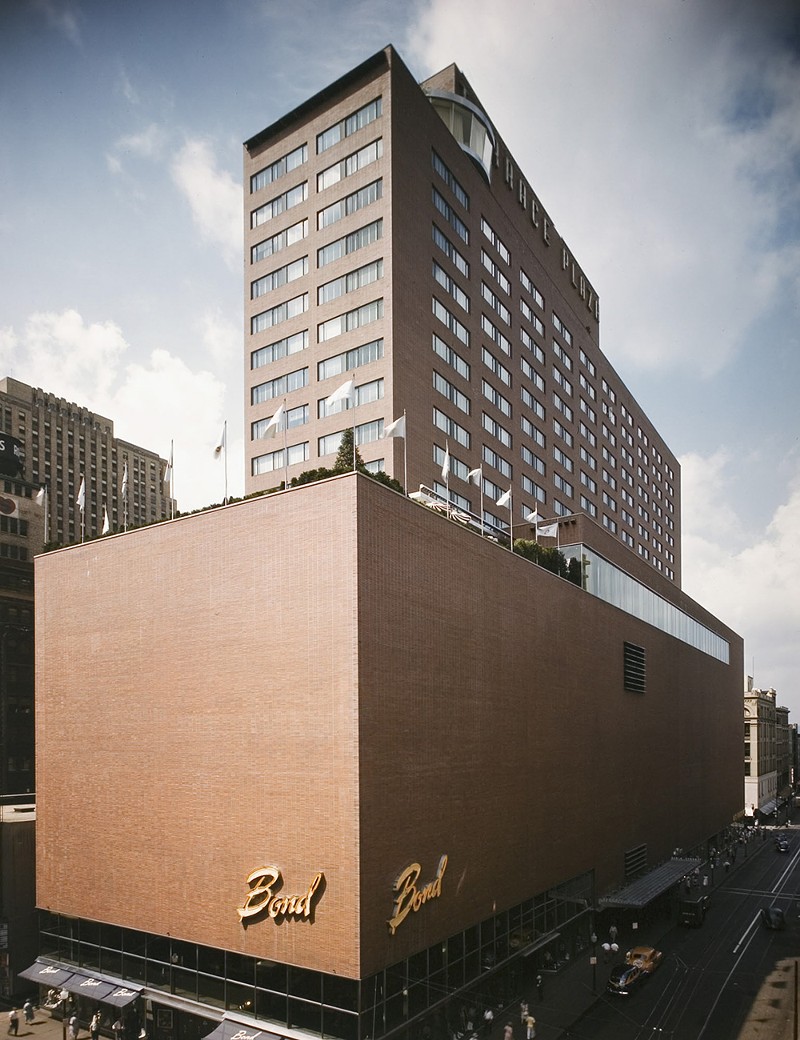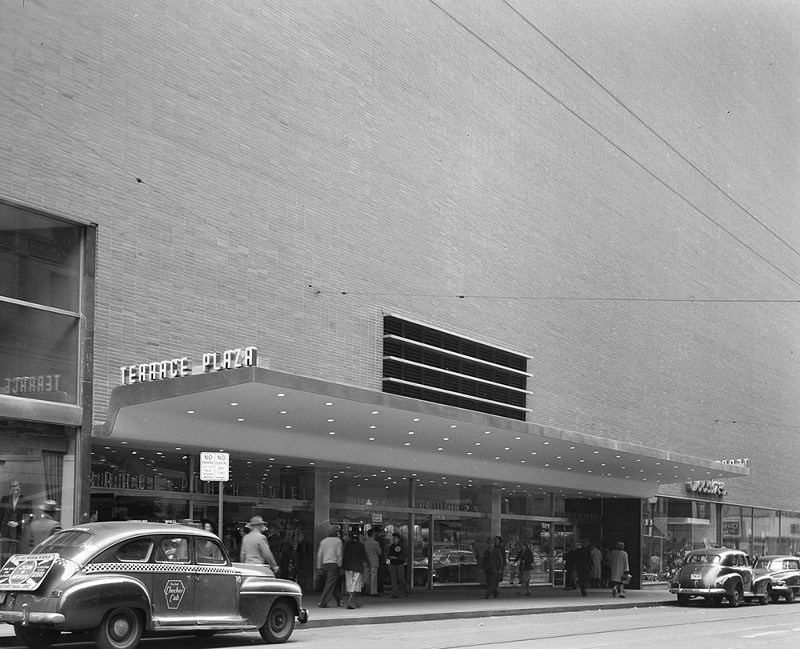
Photo: Ezra Stoller/Esto, Courtesy Cincinnati Preservation Association
The Terrace Plaza Hotel circa 1949
The Terrace Plaza Hotel in downtown Cincinnati is not an official historic landmark.
Cincinnati City Council's Equitable Growth and Housing Committee voted 7-1 against giving the Terrace Plaza Hotel a local historic landmark designation on May 24. Council member Jeff Cramerding was the sole vote for the designation.
This is the second time this year that the council has denied requests from the city's Historic Conservation Board. Members of Cincinnati's Planning Commission said that renovation would be prohibitively expensive within preservation guidelines "as they are drafted today" and recommended against the historic designation. Watch the May 24 Equitable Growth and Housing Committee meeting and landmark discussion.
CityBeat's previous story, dated May 3, 2021:
A historically significant Cincinnati building that people either love to love or love to hate soon will receive the final hearing in its journey toward gaining designated local landmark status.
Or maybe not.
After making its way through Cincinnati’s Historic Conservation Board — which voted to approve it — and the City Planning Commission — which voted against it — the case to bestow official landmark status upon the Terrace Plaza Hotel will soon go before Cincinnati City Council, which has the final say (the hearing date has not been determined as of press time).
Constructed in 1948, the plaza was the first International Style hotel built in the United States and was one of the first hotel construction projects launched after World War II, with a majority of the design work completed by a 24-year-old female architect, Natalie de Blois.
If you’re unfamiliar with the 20-story structure at 15 W. Sixth St., it’s the building that looks like a big brick box with a skinnier brick box sitting on top of it, to inelegantly describe it.
The mixed-use skyscraper features a mostly windowless seven-story base, once home to department stores Bond and JCPenney, with a 12-story structure on top. That had been the location of the former avant-garde Terrace Plaza Hotel and its once grand five-star rooftop restaurant.
At the opening, Harper’s Magazine said the Terrace Plaza Hotel represented the “elegance of this postwar era,” and former Ohio Governor Thomas J. Herbert called it “an insight into the future.” Architectural Forum praised it as “one of the most unusual buildings in all the U.S.,” saying “its art and strikingly modern interiors have made it a name to be dropped by travelers from coast to coast.”
In a city stuffed with romantic and ornate Italianate architecture, the Terrace Plaza’s unadorned Modernist facade has always painted a striking contrast.
And it’s one with national significance.
While the hotel closed in 2008 and the structure has been largely vacant since then — save for a few ground-floor retailers — the Terrace Plaza was listed on the National Register of Historic Places in 2017. In 2020, the National Trust for Historic Preservation placed it on its list of the 11 most endangered historic places in America, calling it “an architecturally innovative building that helps tell the story of ground-breaking female architects.” And in 2022, Docomomo US, a nonprofit dedicated to documenting and conserving Modernist structures, called it one of the “11 most threatened Modern sites.”
But now the Terrace Plaza is up for sale, which is why the Cincinnati Preservation Association, a nonprofit whose mission is to “promote the appreciation, protection and appropriate use and development of the Cincinnati region’s historic buildings, communities and landscapes,” has applied for landmark designation.
“The ownership of the building has been in the courts for many years,” CPA Executive Director Paul Muller tells CityBeat. “And one of the reasons we went for the landmark designation now is because those cases have sorted their way out and it’s moving forward and it’ll be sold at the bankruptcy auction and somebody will be redeveloping it.”
Local landmark designation — which is separate from the Terrace Plaza’s nationally historic designation — is a zoning process, Muller says, and just provides guidelines for what renovations can and cannot be done to a historically significant structure.
“When a building is going to have a change to it in a historic district, or as a local landmark, to get a building permit you have to go to the Historic Conservation Board and show them the work you’re doing. And then they look at it and they decide if it’s consistent with the historic character of the building,” Muller says. “So it allows for a lot of change — you see rooftop decks all over Over-the-Rhine, you see people adding on to buildings that are historic — so it’s very flexible.”
Former Cincinnati City Council member David Mann originally began the process to seek landmark designation for the Terrace Plaza in 2019. Back then, the Historic Conservation Board voted to approve it. Then Mann put the motion on hold. The CPA took up the torch in February of this year.
As it did in 2019, the Historic Conservation Board deemed the Terrace Plaza landmark-worthy in March because it “embodies the distinctive characteristics of a type, period and method of construction” — one of the qualifications set forth in Cincinnati’s municipal code.
But the planning commission looks at different credentials. The commission, which does agree that the building is a historically significant Modernist structure, makes its decision in part based on the “effect of the proposed designation on the surrounding areas and economic development plans of the city.” A majority of members felt the landmark designation would hinder all of the work that needs to be done to even stabilize the building.
Cincinnati Terrace Associates LLC — an affiliate of the New York-based firm JNY Capital — is the current owner of the Terrace Plaza and bought the building in 2018 with plans to renovate it. It has not. And the “failure of the building to be maintained” by Cincinnati Terrace Associates and multiple previous owners has resulted in serious structural and code compliance issues, according to Cincinnati’s Director of the Department of Buildings & Inspections, Art Dahlberg.
In the planning commission hearing held on April 22, Dahlberg detailed the many issues facing the Terrace Plaza: the roof has failed, rain pours inside, the ceiling and walls have collapsed, there’s no fire alarm and some of the masonry is crumbling. He noted an incident that occurred in 2018, when a portion of the facade fell off the roof and lodged itself in the windshield of an occupied car. That resulted in nuisance charges of roughly $60,000 against Cincinnati Terrace Associates LLC — not the first fine the city has leveraged against it. According to Dahlberg, the company has been issued at least 175 civil citations for around $1,000 each.
Cincinnati Terrace Associates LLC has since filed for bankruptcy. Qualified buyers have until May 20 to submit a purchase bid on the Terrace Plaza “equal to or in excess of $10,500,000,” according to court documents. If more than one entity meets or exceeds that $10.5 million bid, the “Hotel Property shall be sold at a virtual public auction” on June 3, per an order from the United States Bankruptcy Court Eastern District of New York. If no one bids, ownership reverts back to the bank/lending institution.
Based on the April planning commission hearing, there are at least two interested redevelopers: Indiana-based Birkla Investment Group, whose Anthony Birkla has said he’s spent nearly $1 million already in federal court fighting JNY Capital for ownership of the Terrace Plaza, and Bloomfield/Schon, a Cincinnati architecture and redevelopment firm that has tackled historic renovation projects like the Peters Cartridge Factory in Maineville and American Can Lofts in Northside.
The main difference between the two redevelopers is that Birkla Investment Group is against landmark designation, while Bloomfield/Schon is for it.
Both firms agree the cost to stabilize the building would be around $3-$5 million, with an additional $30-$50 million investment for redevelopment. Being able to access state and federal historic tax credits would help offset those costs, which might otherwise need to be subsidized in part by the city. As it is already on the National Register of Historic Places, the Terrace Plaza qualifies for federal tax credits. That designation also allows developers to apply for state of Ohio historic tax credits; being “listed as a local landmark by a Certified Local Government” would be a bonus for that.
“The state historic tax credit in Ohio is really powerful,” CPA’s Muller says. “You can get 25% of your cost back. And that’s on top of the federal tax credit, which is 20%. So you add these two together (and) a developer can get 45% of their costs if they do a historic tax credit redevelopment. The Cincinnati Renaissance Hotel was done that way. The City Loft Apartments. The Mercantile building has been done that way. The Tri-State Building, American Can building — all of the major redevelopment of older buildings have been funded by this mechanism. And we think the Terrace Plaza should be funded by that.”

Photo: Shawn Tubb, Courtesy Cincinnati Preservation Association
Architect Natalie de Blois with the Terrace Plaza Miró mural and Calder mobile at the Cincinnati Art Museum
Using either state or federal historic tax credits to help fund a project comes with its own renovation guidelines. But Birkla Investment Group feels that if the Terrace Plaza is made a local landmark, following any guidelines put forth by the Cincinnati Historic Conservation Board would impede their ability to modernize the structure in what they say is a “financially viable way.”
“We don’t dispute the historic nature of the property — we recognize that it’s on the National Register,” said Doug Moormann, who represents Birkla Investment Group, during the April planning commission hearing. “In fact, Mr. Birkla has actually committed to recognizing and honoring the history of this building with public displays. But we will say, if you choose to impose these (landmark) guidelines, you will preserve the idea of the Terrace Plaza, but not the building itself. The imposition of these guidelines will preclude or prevent any redevelopment or adaptive reuse of the Terrace. The building will continue to deteriorate. In just a few short years, the only thing that’s going to be on that site that has any value will be the land.”
Conversely, Steven Bloomfield, principal at Bloomfield/Schon, said during the hearing, “We believe that this landmark building can be revitalized into an important contributor to our downtown. We are prepared to move forward to bring this building back to life,” with Ken Schon, co-owner, adding, “We’ve dealt with buildings way worse than this.”
Bloomfield said the landmark designation would be a boon to help get historic tax credits to assist in renovating the structure.
“Someone once told me that development’s a simple business: Numbers have to add up,” he said. “It’s not an easy business, but if you don’t use tax credits, which total a significant number of the development costs, where’s the money going to come from? It’s going to be someone coming to the city and asking for a significant contribution. It can’t be done otherwise.”
And CPA’s Muller agrees that without the historic tax credit savings, it might not be possible to redevelop the plaza.
“The planning and economic development staff missed a key factor when they speculated that landmark designation would harm or delay redevelopment,” Muller tells CityBeat after the planning commission decision. “In the hearing, there was testimony from a highly qualified developer (Bloomfield/Schon) that a historic redevelopment was the most feasible way to fund the project. Without historic tax credits, the city will need to add millions of subsidies to replace this lost federal and state funding.”
Muller does not believe the Terrace Plaza is in any way on the chopping block for demolition, regardless of how city council comes down on the vote. He believes redevelopers would still use the physical concrete structure in place and then build “a new skin around what there was.”
“It can still be redeveloped, and we’re supportive of that,” Muller says. “And it’s going to be changed. You know, buildings need to change — we’re not trying to fix it. (But) the changes need to be done in a way that’s sensitive to its history.”
Redeveloper Schon is of the same mindset. He told the planning commission, “We think the historic designation as a landmark is appropriate and it would mean that the city and the people would maintain control of the design of the building, or redevelopment and reimagination of this building. And we think that’s appropriate, whether it’s us or somebody else (who redevelops it).”
The biggest drama around the Terrace Plaza — outside of the deteriorating conditions — is the somewhat awkward lower base. Redevelopers seem to be obsessed with its lack of windows, with a large portion of the conversation during the planning commission hearing devoted to them.
Anthony Birkla of Birkla Investment Group said to make the space appealing to modern-day tenants, they’d need to put in giant windows on those first seven floors and above, which he doesn’t think the Historic Conservation Board would approve.
Schon said during the hearing that’s probably true, but he finds the windows to be “adequate,” especially for his group’s plans to use the lower levels as a garage and upper levels as luxury apartments with Midcentury design.
CPA’s Muller tells CityBeat, “structural engineers who have studied the building and the floors say it can support parking.” He also references similar renovation projects that saved and restored Midcentury hotels like the Statler Hotel in Dallas or the Loews Hotel in downtown Philadelphia.
“There’s a creative way to approach the building, get the tax credits, and have it be very successful and then build on its legacy. Legacy has asset value,” Muller says.

Photo: Ezra Stoller/Esto, Courtesy Cincinnati Preservation Association
Outside the Terrace Plaza Hotel circa 1949
The aforementioned architect de Blois — who launched her career working for Skidmore, Owings & Merrill, which built the plaza and is now a major architectural firm — was before her time.
“She’s now considered one of the pioneers of modern architecture in America and never got credit in her life,” Muller says.
de Blois constructed a vision for a building filled with Modernist art, futuristic push-button elevators (Architectural Digest says the plaza was the first hotel without human elevator operators) and space-age conveniences, like motorized beds that unfurled from the walls and guest-operated thermostats. A prescient nod to the coming Atomic Age design of the 1950s, the hotel decor incorporated organic shapes and Formica, terrazzo and metal finishes.
“(She) pulled together fabrics, dinnerware, uniforms, Modern art and she went and worked with the Modern artists — (Joan) Miró and Saul Steinberg. I mean, it was just such a comprehensive view of how to create a place in the world,” Muller says.
Two iconic site-specific commissions for the Terrace Plaza — one by Miró and one by Steinberg — are now part of the Cincinnati Art Museum’s collection, as is a mobile by Alexander Calder that once hung in the eighth-floor hotel lobby. Miró’s work graced the top-floor Gourmet Room and Steinberg’s “Mural of Cincinnati” was located in the Skyline Restaurant in the lobby.
And while perhaps whatever the Terrace Plaza becomes will not be as groundbreaking as its first iteration, its past still has a future in Cincinnati.
“There was a time in Cincinnati when people viewed it as a choice, you know, historic preservation or economic redevelopment,” Muller says. “We’re past that point now. Historic preservation has been our biggest driver of economic redevelopment in Cincinnati.”
Allison Babka and Nick Swartsell contributed reporting to this story.
Stay connected with CityBeat. Subscribe to our newsletters, and follow us on Facebook, Instagram, Twitter, Google News, Apple News and Reddit.
Send CityBeat a news or story tip or submit a calendar event.

